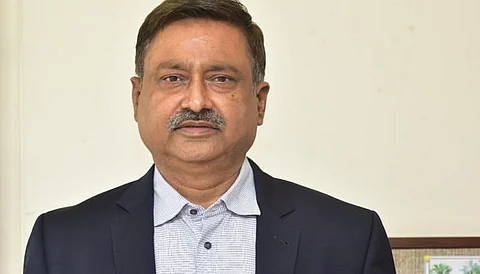
- News Updates
- PSU Watch
- Defence News
- Policy Watch
- हिन्दी न्यूज़
- Jobs Watch
- States News
- Event News

New Delhi: Indian Strategic Petroleum Reserves Limited (ISPRL) is looking at tripling its capacity from the current 5.33 Million Metric Tonnes (MMT) to 15 MMT in the next 10 years, said its Chief Executive Officer (CEO) and Managing Director (MD) LR Jain. In an interview with PSU Watch on the sidelines of India Energy Week (IEW) 2025, Jain spoke about plans of ISPRL to explore feasibility of setting up natural gas reserves in Rajasthan’s salt caverns, which would be a first in India and which could later also pave way for storing hydrogen in the future.
ISPRL is a Special Purpose Vehicle (SPV), which is a wholly owned subsidiary of Oil Industry Development Board (OIDB). It currently has three strategic petroleum reserves with a combined capacity of 5.33 MMT at Vishakhapatnam, Mangaluru and Padur. These are excavated rock caverns and they hold crude oil only. In the phase-II expansion plan, ISPRL is looking to augment storage capacity further by creating an additional 6.5 MMT of strategic petroleum reserves at Chandikhol in Odisha (4 MMT) and another at Padur (2.5 MMT) in Karnataka.
Here are excerpts from the interview:
ISPRL has a very ambitious capacity augmentation plan. The phase-II expansion is already underway. What are the updates? And with India poised to see an increase in energy consumption, what are the plans for the future?
See, ISPRL is into strategic reserves. We have already completed the phase-1 of strategic reserves, which now stands at 5.33 MMT. And we have two projects which are in progress which will add another 6.5 MMT. In addition, we are doing some more feasibility studies. ISPRL aspires to increase SPR capacity from 5 MMT to 15 MMT in the next 10 years.
Have any agreements been signed here at IEW?
No. Because we are not at that juncture. We signed some agreements last year. We rented our cabins in Vizag, HPCL (Hindustan Petroleum Corporation Ltd). We signed the agreement last time. This year, we have already signed an agreement with MRPL (Mangalore Refinery and Petrochemicals Ltd) in January.
Few things are going on, like discussions are underway with ADNOC (Abu Dhabi National Oil Company) because we are going to extend our existing agreement which is expiring in May 2025.
What are the terms and conditions under which ISPRL is leasing out its reserves because these are our strategic reserves? How does it benefit us?
In line with our mandate to rent 30 percent of our capacity, we have rented 300 TMT space in Vizag caverns to HPCL. Under such rent agreements, the lessee can utilise the rented capacity for its commercial use. However, in case of any emergency situation, the government has the first right on the crude available in the caverns. ISPRL is expected to cover its operational expenses from such commercialisation activities, and at the same time, the interest of the government is protected by way of having first right on crude available in the caverns. It is a very well-designed model where we can look at our strategic interest as well as commercial interest.
You have signed an agreement with MRPL in January. Are you in talks with other OMCs?
We are exploring various options.
What is the timeline for the expansion of your capacity under phase-II and how much will it cost?
The phase-II expansion will cost around Rs 15,000 crores. And the timeline for completion would be around five-to-six years.
And beyond phase-II expansion, what are the plans for capacity augmentation? Which locations are currently on your radar?
We are doing a feasibility study in Rajasthan’s Bikaner for about 5-MMT capacity in salt caverns. Feasibility studies at Mangalore for about 1.5 MMT capacity is already completed and we are initiating process of necessary approvals. Preliminary Feasibility study for about 1-1.5-MMT capacity rock caverns at Bina in Madhya Pradesh is also underway. With these plans, we are in the right direction to go towards 15 MMT.
In the past two years, we have seen an uptick in gas consumption. Now, the International Energy Agency (IEA) has also projected a 60 percent rise in India’s gas consumption by 2030. In addition, there is the imperative of energy transition. Do all these factors add up for ISPRL to look beyond crude oil reserves?
Yes, absolutely. So, in the feasibility study we are doing in salt caverns in Bikaner, Rajasthan, along with EIL (Engineers India Ltd), we are exploring the possibility of storing gas. These studies should be completed in the next three months. Salt caverns also have potential to store hydrogen, considering that Rajasthan has high potential for solar power which can be used to make Hydrogen. This is our wish list.
I am speculating when I say this. But you know that the National Critical Mineral Mission has been launched, and the government is looking at creating a stockpile of critical minerals. So, is that something that ISPRL would ever consider?
As of now, we have no plans to store critical minerals.
